BOARDWATCH: Chicago Board of Education meeting of July 23, 2014 highlighted by large public protests against budget lies before the Board doubles down and votes to approve its $6.8 billion budget for the 2014 - 2015 school year
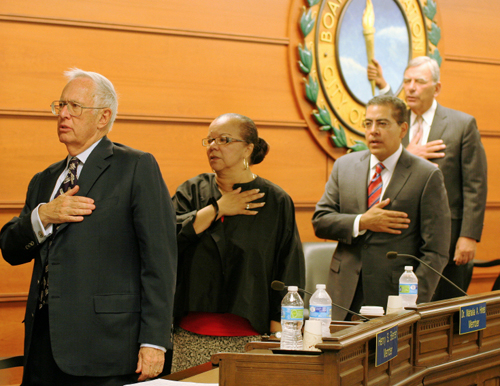 Six of the seven members of the Board of Education were present for the July 23, 2014 Board meeting. Above, left to right, Henry Biened, Mahalia Hines, Jesse Ruiz, and David Vitale. Substance photo by David Vance.The Chicago Board of Education began its July 23, 2014 meeting at a little after 10:30 a.m. The roll call showed that six of the seven members of the Board were present, along with "Chief Executive Officer" Barbara Byrd Bennett and General Counsel James Bebley.
Six of the seven members of the Board of Education were present for the July 23, 2014 Board meeting. Above, left to right, Henry Biened, Mahalia Hines, Jesse Ruiz, and David Vitale. Substance photo by David Vance.The Chicago Board of Education began its July 23, 2014 meeting at a little after 10:30 a.m. The roll call showed that six of the seven members of the Board were present, along with "Chief Executive Officer" Barbara Byrd Bennett and General Counsel James Bebley.
The Board members were, as usual, surrounded by an array of highly paid executives with various titles, many of them new, and some 'rebranded' from previous years. The executives ranged from "Chief Talent Officer" (Alicia Winckler) and "Chief of Chiefs" (Denise Little) to Chief Officer for College and Career Success (Aarti Dhupelia), the "Chief Administrative Officer" (Tim Cawley) and others. Missing for this meeting were the "Chief Innovation and Incubation Officer" (Jack Elsey) and the Chief Portfolio Officer (who seems to have disappeared, although the "Portfolio Office" remains on the books). Since the main topic on the agenda was the massive (more than $6 billion) budget, an examination of such executive people and organizational titles (and departments) is worthwhile. There are many challenges for those trying to follow the Chicago Board of Education's budget tricks. These tricks are especially innovative in the bureaucratic sections as the nation's third largest school system, as CPS continues hiring executives at salaries between $125,000 and $190,000 per year. Most of these come from outside the school system (and often from outside Illinois). Critics have a difficult time even finding where the Board has relocated various individuals and departments. Meanwhile, CPS is claiming that it has, once again -- for the 14th time since the beginning of the century -- reduced "administration." 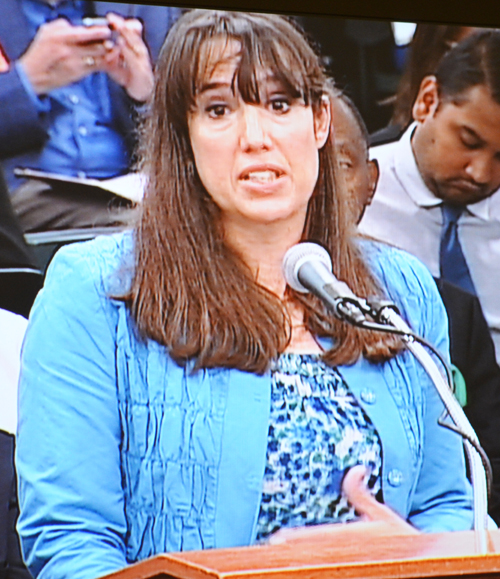 Chicago Public Schools Chief Financial Officer Ginger Ostro presented the budget Power Point and then answered questions from Board members at the beginning of the July 23, 2014 Board meeting. Substance photo by George N. Schmidt.On July 23, 2013, two Chief Financial Officers were present in the Board chambers during the Board meeting. For the first time, former Budget Director Ginger Ostro was sitting among the executives a few feet from Barbara Byrd Bennett, the "Chief Executive Officer.." Ostro was there, having been named "Chief Financial Officer" a month earlier. But Ostro's predecessor, Peter Rodgers, was sitting among the parents and teachers in the audience for a time, notable only for his expensive suit, unusual in the row in which he was sitting. As the meeting began, two aldermen arrived and sat in the front row.
Chicago Public Schools Chief Financial Officer Ginger Ostro presented the budget Power Point and then answered questions from Board members at the beginning of the July 23, 2014 Board meeting. Substance photo by George N. Schmidt.On July 23, 2013, two Chief Financial Officers were present in the Board chambers during the Board meeting. For the first time, former Budget Director Ginger Ostro was sitting among the executives a few feet from Barbara Byrd Bennett, the "Chief Executive Officer.." Ostro was there, having been named "Chief Financial Officer" a month earlier. But Ostro's predecessor, Peter Rodgers, was sitting among the parents and teachers in the audience for a time, notable only for his expensive suit, unusual in the row in which he was sitting. As the meeting began, two aldermen arrived and sat in the front row.
The required Power Point moment came this month from Ginger Ostro, who has become Chief Financial Officer of CPS. The Power Point contained the same information that the Board provided to the public at the three hearings on July 16 at Wright College, Malcolm X College and Kennedy King College. (See http://www.substancenews.net/articles.php?page=5111�ion=Article.) After she completed the Power Point, Ostro answered questions from most of the Board member. Probably the most important came from Andrea Zopp, who asked pointedly whether CPS might experience "cash flow" issues later in the fiscal year because of the unique way of recognizing revenue for the coming fiscal year. Ostro said that it was possible.
Board President David Vitale announced that the hearing transcripts had been provided to the Board members after they were posted on Friday, July 18. (The transcripts can be found on the Board's website, although it takes a bit of searching). Vitale also said that the Board had continued to keep cuts "away from the classroom" (while many people in the audience moaned audibly) and then said that the Board could have raised class size and laid off "students" -- he quickly corrected himself and said "teachers" -- but the Board chose to continue its supposed commitment to the classrooms.
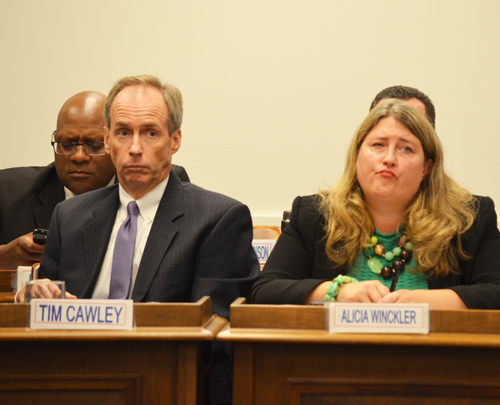 CPS 'Chief Administrative Officer' Tim Cawley ($215,000 per year plus possible bonuses) and "Chief Talent Officer" Alicia Winckler ($205,000 per year plus bonuses) at least were listening during the budget presentation by Ginger Ostro. Chief FACE Officer Phillip Hampton (behind Cawley) was occupying himself as most CPS executives do during Board meetings by reading his email and messaging. Substance photo by George N. Schmidt.After the budget discussion, Barbara Byrd Bennett reported that CPS was (again) amending its "Principal Eligibility Policy." When asked by Board member Carlos Azcoitia whether "internal and external candidates will have the same eligibility requirements..." Byrd Bennett answered "Yes." By 11:30 a.m. the discussions had finished, and Vitale noted that public officials wanted to speak. The first was Alderman Bob Fioretti of the Second Ward, whose remarks are here:
CPS 'Chief Administrative Officer' Tim Cawley ($215,000 per year plus possible bonuses) and "Chief Talent Officer" Alicia Winckler ($205,000 per year plus bonuses) at least were listening during the budget presentation by Ginger Ostro. Chief FACE Officer Phillip Hampton (behind Cawley) was occupying himself as most CPS executives do during Board meetings by reading his email and messaging. Substance photo by George N. Schmidt.After the budget discussion, Barbara Byrd Bennett reported that CPS was (again) amending its "Principal Eligibility Policy." When asked by Board member Carlos Azcoitia whether "internal and external candidates will have the same eligibility requirements..." Byrd Bennett answered "Yes." By 11:30 a.m. the discussions had finished, and Vitale noted that public officials wanted to speak. The first was Alderman Bob Fioretti of the Second Ward, whose remarks are here:
My name is Alderman Bob Fioretti, and I am here today to talk about Montefiore, the last therapeutic day school in CPS. I have been the alderman of the 2nd Ward for the last seven years, and Montefiore is in my ward. I have seen some great work done for students at that school. Montefiore has operated since 1929, helping boys with severe behavioral and emotional issues. The students at Montefiore need special services. Outside of a therapeutic environment, these students are at high risk for being suspended repeatedly, getting involved in violence and disrupting their classes. A school like Montefiore should be on the front line for preventing violence in school and on the street.
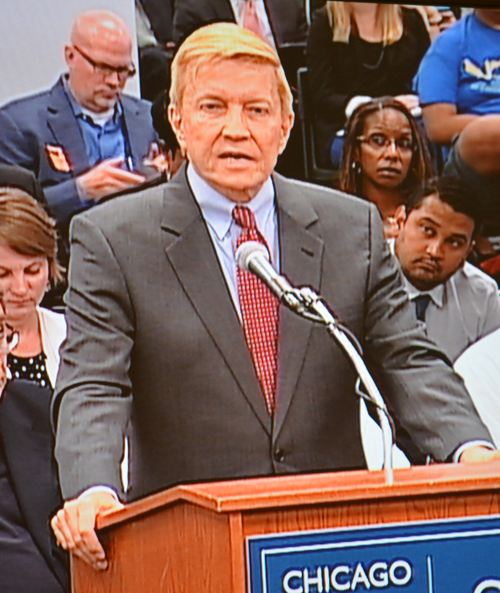 Alderman Bob Fioretti criticized the Board for sabotaging Montefiore schools. Substance photo by George N. Schmidt.I am here today representing a group of Aldermen who are concerned about the situation at Montefiore. After closing its other two therapeutic day schools last year, and consolidating those students in Montefiore, CPS has failed to assign any new students to Montefiore. After graduation this June, there were very few students left at Montefiore, so CPS layed off most of the teachers in the school. This is a pattern at Montefiore, where there have been several principals in the last few years. I introduced a resolution in the City Council in 2009 asking for an investigation of underfunding and the failiure to assign students to Montefiore. CPS provided damaging testimony at this hearing, and many community members, teachers and principals raised concerns about students who did not receive necessary IEPs, and students who dropped out of school after serving time in Juvenile Detention.
Alderman Bob Fioretti criticized the Board for sabotaging Montefiore schools. Substance photo by George N. Schmidt.I am here today representing a group of Aldermen who are concerned about the situation at Montefiore. After closing its other two therapeutic day schools last year, and consolidating those students in Montefiore, CPS has failed to assign any new students to Montefiore. After graduation this June, there were very few students left at Montefiore, so CPS layed off most of the teachers in the school. This is a pattern at Montefiore, where there have been several principals in the last few years. I introduced a resolution in the City Council in 2009 asking for an investigation of underfunding and the failiure to assign students to Montefiore. CPS provided damaging testimony at this hearing, and many community members, teachers and principals raised concerns about students who did not receive necessary IEPs, and students who dropped out of school after serving time in Juvenile Detention.
After these hearings, CPS worked hard to improve the curriculum, teaching and services at Montefiore under Dr. Richard Smith, the former network chief and head of OSES. There is no excuse: CPS should be able to provide outstanding care in Montefiore.
I have given you a letter and supporting material that asks the Board to return Montefiore to a working therapeutic school so that it can continue to serve the children in Chicago. The concerned aldermen and community representatives would like to meet with Dr. Barbara Byrd-Bennett and those making the decisions about Montefiore as soon as possible, so that we can work together to get this school back up and running. This is an important step in stemming violence in schools and on the streets of Chicago.
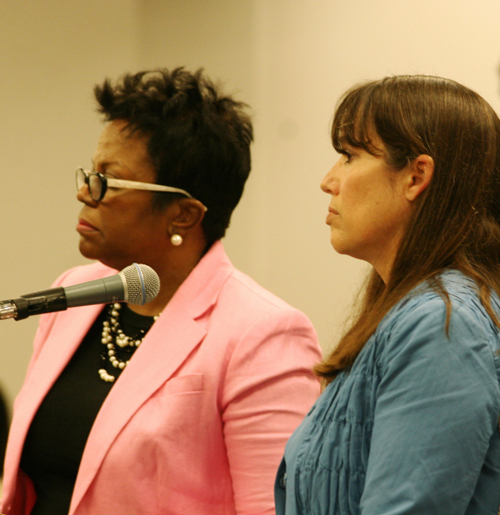 Denise Little (in pink), the "Chief of Chiefs" -- she oversees the so-called "Networks" (the latest innovative name CPS has given to its sub-districts; like all innovative and incubational and disruptive paradigm shifters, those who run Chicago's public schools like to give Orwellian names to obvious things, thereby keeping the average citizen from figuring out what the Board is talking about) -- was the one called on during the budget presentation by Chief Financial Officer Ginger Ostro (in blue) to explain why CPS was once again cutting back on real public school programs. Trying to explain the termination of the Simeon High School electrical program, Little claimed that too few students had signed up for it. Substance photo by David Vance. If we are really serious as a city about healing and solving the issues of violence and other problems that plague our communities, how can we turn our backs on schools like Montefiore? We can�t police our way out of this, we can�t tax our way out of this, we can�t ignore our way out of this and hope things magically get better. We need action. We need to get to the root of this and offer HELP and guidence to our young residents MOST in distress and in need. If we turn our backs on THEM, what does that say about US as leaders?
Denise Little (in pink), the "Chief of Chiefs" -- she oversees the so-called "Networks" (the latest innovative name CPS has given to its sub-districts; like all innovative and incubational and disruptive paradigm shifters, those who run Chicago's public schools like to give Orwellian names to obvious things, thereby keeping the average citizen from figuring out what the Board is talking about) -- was the one called on during the budget presentation by Chief Financial Officer Ginger Ostro (in blue) to explain why CPS was once again cutting back on real public school programs. Trying to explain the termination of the Simeon High School electrical program, Little claimed that too few students had signed up for it. Substance photo by David Vance. If we are really serious as a city about healing and solving the issues of violence and other problems that plague our communities, how can we turn our backs on schools like Montefiore? We can�t police our way out of this, we can�t tax our way out of this, we can�t ignore our way out of this and hope things magically get better. We need action. We need to get to the root of this and offer HELP and guidence to our young residents MOST in distress and in need. If we turn our backs on THEM, what does that say about US as leaders?
Following Alderman Fioretti's remarks, Alderman Howard Brookins Jr. spoke about the situation the Board has created by getting rid of the only electricity shop teachers at Simeon High School. Brookins told the Board that he wanted the teacher restored to the school and the program expanded and supported. Earlier, the Board had heard from "Chief of Chiefs" Denise Little, who said the program was closed because not enough students had chosen to sign up to take it. Brookins reminded the Board that a larger number of students were already in the program, and that depriving them of the program was going to disrupt their training and their prospects for a career.
Following Brookins was Chicago Teachers Union Recording Secretary Michael Brunson. Brunson criticized the Board for reducing Career and Technical Education (CTE) subjects across the city. Brunson said that the Board had been eroding and privatizing shop classes and career education offerings across the city for years, and that the failure of the Board to provide these programs was hurting the children.
Later, the union issued a lengthy statement on the destruction of CTE programs by the Chicago Board of Education. The statement, which included Brunson's remarks to the Board meeting, follows here:
CHICAGO TEACHERS UNION CRITIQUE OF THE DESTRUCTION OF VOCATIONAL EDUCATION PROGRAMS BY THE CHICAGO BOARD OF EDUCATION:
This loss of labor training comes at a time when minimum wage jobs are the only future prospects for many adults in Chicago, yet city leaders are eliminating programs that produce skilled workers. At a time when violence is a key concern in the city of Chicago and economic development proves to be a strong deterrent to widespread criminality, the programs that provide alternatives are being shut down. The sad fact is that Simeon is just one example of what is happening throughout CPS.
�Let�s be realistic�not everyone is interested in attending (or can even afford) college,� said Chicago Teachers Union (CTU) President Karen Lewis. �Some people have extremely successful careers in blue collar jobs as carpenters, auto mechanics, electricians and plumbers. Many can pursue lucrative careers in graphic design and commercial art. By reducing our students� access to vocational training, CPS is reducing their chances to earn decent livings as they become adults. In a city of nearly three million people, CPS graduates fewer than 30 welders, 30 HVAC qualified workers, 30 cabinet makers and 30 electricians per year. This is unacceptable.�
Lewis said although the district is shifting to STEM learning, all students should be given career awareness programs beginning in 7th and 8th grades, with career path preparation taking place in the 9th grade. �Young people can then make informed decisions about their adult lives, and should they choose a career in those fields, they will be prepared to take advantage of apprenticeship and cooperative work programs,� she said. �That way, they can begin to accumulate experience, resources and eventually wealth.�
For more than a decade, the city�s school district has systematically eliminated and dismantled the CTE courses that prepare students for high-paying jobs in the construction trades, manufacturing and public service, in addition to automotive, architecture and drafting careers. Valuable programs that taught practical skills to use at home, in the community and as preparation for the workplace have been eliminated from schools in Chicago. The irony is that while these programs are diminished and eliminated in Chicago, this is not the case in other districts throughout Illinois. Other districts are building and developing CTE centers and reinvigorating home economics.
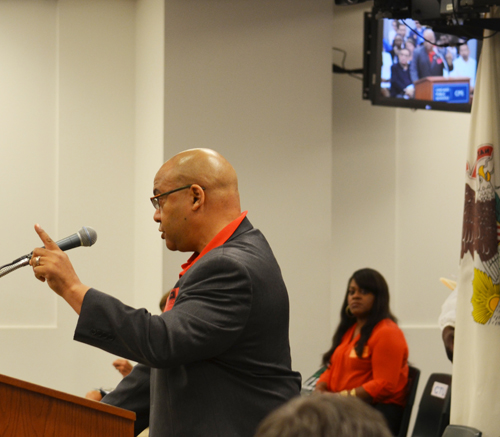 Chicago Teachers Union Recording Secretary Michael Brunson spoke forcefully against the Board's latest reductions in vocational education programs, the most recent the destruction of the electricity program at Simeon High School. Latisa Kindred, the teacher who was forced out of Simeon, signed up to speak at the Board meeting, but was a no show. Behind Brunson is Shoeneice Reynolds, who spoke against the Board's policies later during the meeting. Substance photo by George N. Schmidt. Michael Brunson, recording secretary for the CTU and a former manufacturing labor coordinator before becoming a teacher, added, �We are pushing a lot of our students through the system without employable skills or work experience. What happens to communities when you have an entire generation of youth people unable to find jobs and unable to open their own businesses? We are condemning an entire segment of our population to low-skill, low-wage work.
Chicago Teachers Union Recording Secretary Michael Brunson spoke forcefully against the Board's latest reductions in vocational education programs, the most recent the destruction of the electricity program at Simeon High School. Latisa Kindred, the teacher who was forced out of Simeon, signed up to speak at the Board meeting, but was a no show. Behind Brunson is Shoeneice Reynolds, who spoke against the Board's policies later during the meeting. Substance photo by George N. Schmidt. Michael Brunson, recording secretary for the CTU and a former manufacturing labor coordinator before becoming a teacher, added, �We are pushing a lot of our students through the system without employable skills or work experience. What happens to communities when you have an entire generation of youth people unable to find jobs and unable to open their own businesses? We are condemning an entire segment of our population to low-skill, low-wage work.
�The national mantra for education states that our public schools are to prepare students for college and career, yet all too often, there is a massive emphasis on �college� instead of �career.� For those students not attending college, �career� refers to workplace skills needed in construction trades, information technology, manufacturing, service fields and entrepreneurship, but CPS seems to have redefined �career� as only fields that require a four-year college degree. Training for apprenticeships, internships, certificates and career choices that do not require a four-year degree is on the decline.�
�Electricity in CPS is the fourth program to close at Simeon in four years�first it was graphic design, then machine shop, then auto shop and now electricity,� said former Simeon teacher Latisa Kindred, the district�s only female, African-American Electricity educator who was recently laid off. �They need to save CTE, because my students leave this program and find jobs, and that�s an alternative to what they face on the streets.�
Kindred and other CTE teachers report that they have a higher level of classroom engagement and fewer dropouts, as their students find value in working in trades, manufacturing and service industries, dignity in choosing careers such a carpentry, and personal satisfaction and value to the community and society through preparation for jobs as builders, manufacturers, and service workers. National research supports this valuable role for CTE classes. As violence in Chicago and other urban centers increases, it is time to consider replacing weapons with tools in the hands of youth and confronting hopelessness with the security of useful skills and guaranteed earning power.
Vocational education was a mainstay in CPS until 1995, when Mayor Richard M. Daley took control of the school district. In the last decade, vocational education was rebranded as �career and technical education� as a way to stimulate division in the labor movement between �workers� and �professionals.� Reportedly, while CTE teachers have industry experience in the trades they teach, those running the program at the Chicago Board of Education have no industry or education experience in the fields�only business backgrounds.
�Our students deserve the opportunity to try all subjects that are of interest to them,� Lewis said.
�Learning through hands-on activities has proven effective for retention of students who are inclined to leave school prior to high school graduation. We don�t want our youth out on the streets, unable to access jobs and resources but able to access to guns and drugs.�
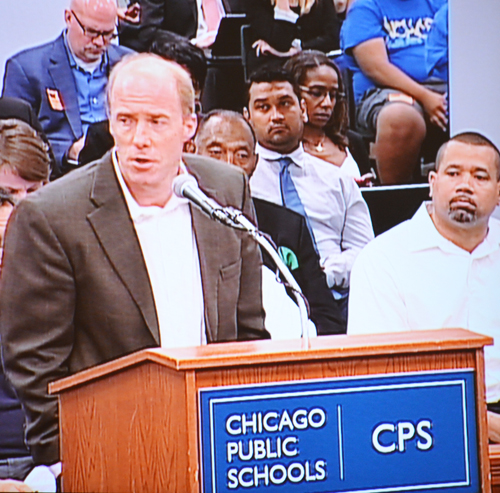 Andrew Broy of the Illinois Network of Charter Schools spoke at the Board meeting. Substance photo by George N. Schmidt.After Brunson's comments, the Board began what is called "public particiipation." During that time, citizens who had taken the time to navigate the complicated registration process are allowed to comment on Board policies and, ostensibly, to ask questions of the Board members. As usual, the Board members showed their hostility (which became violent) to those who questioned or challenged them, while being solicitous towards any praise for their activities.
Andrew Broy of the Illinois Network of Charter Schools spoke at the Board meeting. Substance photo by George N. Schmidt.After Brunson's comments, the Board began what is called "public particiipation." During that time, citizens who had taken the time to navigate the complicated registration process are allowed to comment on Board policies and, ostensibly, to ask questions of the Board members. As usual, the Board members showed their hostility (which became violent) to those who questioned or challenged them, while being solicitous towards any praise for their activities.
The first person to speak from the list of those signed up for public participation was Jennifer Biggs of the Raise Your Hand Coalition. She presented a brief but detailed critique of the Board's budget, focusing on the expansion of charter schools at the expense of the city's real public schools. She said that her group wanted the Board to shut down several central office departments, reduce others, and put in a moratorium on further charter expansion.
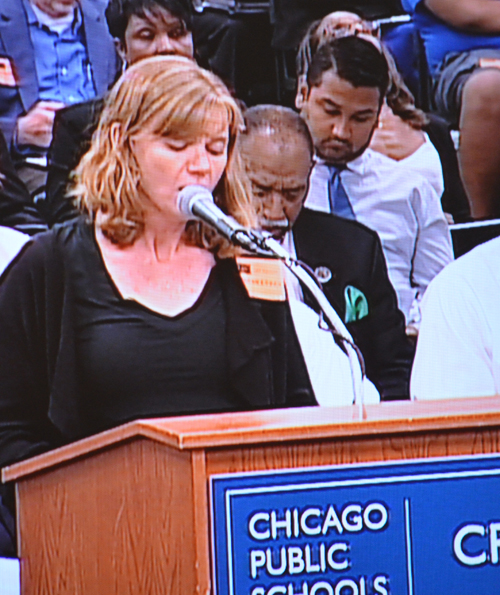 Jennifer Biggs of the Raise Your Hand Coalition demanded that CPS reduce or eliminate a number of central office departments and put in place a moratorium on further charter school expansion. Substance photo by George N. Schmidt.Biggs's remarks were followed by Andrew Broy, of the Illinois Network of Charter Schools (INCS), who oppose the moratorium on charters and continued to repeat the talking points which claim that charters are expanding because of parental "choice."
Jennifer Biggs of the Raise Your Hand Coalition demanded that CPS reduce or eliminate a number of central office departments and put in place a moratorium on further charter school expansion. Substance photo by George N. Schmidt.Biggs's remarks were followed by Andrew Broy, of the Illinois Network of Charter Schools (INCS), who oppose the moratorium on charters and continued to repeat the talking points which claim that charters are expanding because of parental "choice."
Reem Evangelista, a teacher at Bridge school, was one of two speakers who asked the Board why relief from the overcrowding at their school was not on the agenda for the Board's capital improvements. Evangelista suggested that if the Board couldn't afford to build an annex for the school, that the Board could move unused mobile classrooms from nearby Taft and Steinmetz high schools to help relieve the situation at Bridge. Adding to the appeal for Bridge was Patricia Walenga, who told the Board that she was currently serving on the Bridge Local School Council, but that she had been working for the school since "before there was a local school council." She recounted a big of local history, reminding the Board members of how little Chicago knowledge and experience the Board has under the new mayoral regime (which only hires executives from out of town, and only those with no teaching experience but with MBA degrees). Walenga said that her work with Bridge school goes back to the days when the schools' had "Local School Improvement Councils" with no real power. (The LSCs were put into power in 1988; this reporter served on the first LSC at Amundsen High School as one of two teacher reps). 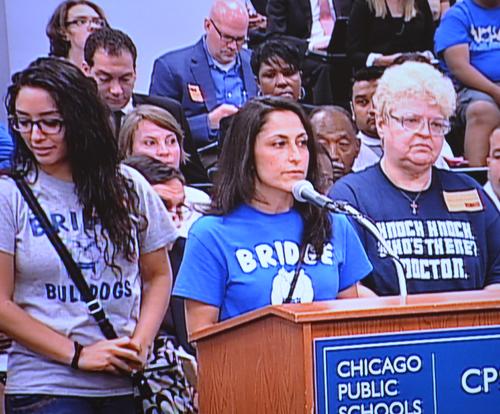 Bridge Elementary School teacher Reem Evangelista (at microphone) was joined by veteran local school leader Patricia Walenga (right above) in asking the Board to provide Bridge with an annex to relieve the school's overcrowding. If an annex can't immediately be built, the Bridge people asked, then the Board should move the unused mobile classrooms from nearby Taft and Steinmetz high schools to Bridge. Substance photo by George N. Schmidt.Walenga gave the facts about the slow but steady increase in the student population at Bridge to the point now where the school is juggling every available space to serve its ever growing student population. The next two speakers were from Lane Tech (currently "Lane College Prep") High School who demanded that the Board of Education stop stalling on the reinstatement of the school's swimming coach. The coach, according to the speakers, had been removed from the school after a false accusation of sexual misconduct was made against him. Standing with several members of the swimming teams from Lane Andrea Gullickson asked the Board members why the coach was not back at the school after a DCFS investigation cleared him. A second speaker, Kim Boettcher, repeated the same demand. The Lane people said that the swim team students, who had learned a great deal from their coach, were being deprived of their rights while the Board's lawyer ferreted around further in a case that has already been resolved.
Bridge Elementary School teacher Reem Evangelista (at microphone) was joined by veteran local school leader Patricia Walenga (right above) in asking the Board to provide Bridge with an annex to relieve the school's overcrowding. If an annex can't immediately be built, the Bridge people asked, then the Board should move the unused mobile classrooms from nearby Taft and Steinmetz high schools to Bridge. Substance photo by George N. Schmidt.Walenga gave the facts about the slow but steady increase in the student population at Bridge to the point now where the school is juggling every available space to serve its ever growing student population. The next two speakers were from Lane Tech (currently "Lane College Prep") High School who demanded that the Board of Education stop stalling on the reinstatement of the school's swimming coach. The coach, according to the speakers, had been removed from the school after a false accusation of sexual misconduct was made against him. Standing with several members of the swimming teams from Lane Andrea Gullickson asked the Board members why the coach was not back at the school after a DCFS investigation cleared him. A second speaker, Kim Boettcher, repeated the same demand. The Lane people said that the swim team students, who had learned a great deal from their coach, were being deprived of their rights while the Board's lawyer ferreted around further in a case that has already been resolved.
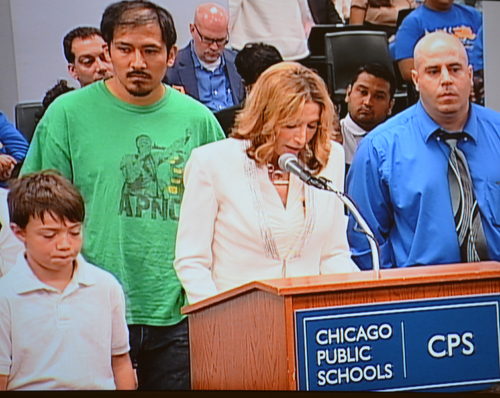 Catherine Cunningham-Yee, a teacher at Hanson Park Elementary, told the Board about the unsafe conditions in the rented "annex" building that the Board has for the school. The entire school community has been urging the Board to provide the capital development funds to build an annex building to relieve the overcrowding at the northwest side school. On Cunningham-Yee's left (blue shirt) is George Ramirez, who has been trying to bring the dramatic details of the overcrowding problem at their school to the Board members for months. Substance photo by George N. Schmidt.The next speaker was one of a handful who show up at every Board meeting to repeat what Substance and others have come to call the "Charter School Salvation Narrative." Teacher Brian Riddick was the first of them. He spoke on behalf of the "Noble Network of Charter Schools." His story was basically that only charter school teachers -- like he and his colleagues -- go out of their way all the time for their students. According to this version of the narrative, that's the reason why Noble does better, that is the charter difference, and that is why the Board should continue to expand the charter schools in Chicago. The student variation on the same theme came later in the meeting. Anthony Driver, from Chicago International Charter School Ralph Ellison "campus," said he had successfully finished college because of the charter school. Jair Olivares. another Noble charter school promoter, delivered a carefully prepared and dramatic speech about how he was despairing about getting into one of the Ivy League colleges of his choice as he received rejections from them, one after another. Then, thanks to one last push by his teachers and counselors at the "Pritzker Campus", he sent in his application to Harvard -- and was accepted.
Catherine Cunningham-Yee, a teacher at Hanson Park Elementary, told the Board about the unsafe conditions in the rented "annex" building that the Board has for the school. The entire school community has been urging the Board to provide the capital development funds to build an annex building to relieve the overcrowding at the northwest side school. On Cunningham-Yee's left (blue shirt) is George Ramirez, who has been trying to bring the dramatic details of the overcrowding problem at their school to the Board members for months. Substance photo by George N. Schmidt.The next speaker was one of a handful who show up at every Board meeting to repeat what Substance and others have come to call the "Charter School Salvation Narrative." Teacher Brian Riddick was the first of them. He spoke on behalf of the "Noble Network of Charter Schools." His story was basically that only charter school teachers -- like he and his colleagues -- go out of their way all the time for their students. According to this version of the narrative, that's the reason why Noble does better, that is the charter difference, and that is why the Board should continue to expand the charter schools in Chicago. The student variation on the same theme came later in the meeting. Anthony Driver, from Chicago International Charter School Ralph Ellison "campus," said he had successfully finished college because of the charter school. Jair Olivares. another Noble charter school promoter, delivered a carefully prepared and dramatic speech about how he was despairing about getting into one of the Ivy League colleges of his choice as he received rejections from them, one after another. Then, thanks to one last push by his teachers and counselors at the "Pritzker Campus", he sent in his application to Harvard -- and was accepted.
As these salvation stories roll out month after month after month, the observer (or perhaps the Board member) would begin to believe that only the charter schools -- or at least those preparing the self-promotional presentations -- have highly successful students who are capable of getting accepted into some of the nation's elite universities. Since teachers, principals, and students from the city's real public schools never take the day off to come and sell the same stories in front of the Board, an observer who didn't know better would eventually believe that children who don't make it into the charter schools (and survive the push out process) are doomed to violence and a dead end future. Since he became mayor, Rahm Emanuel has routinely appeared at charter school promotional events, while never doing the same at the city's real public schools. His charter school appearances are always accompanied by a heavy push for the news media to join him at the publicity stunt. After the second iteration of the charter schools' salvation narrative was finished (Andrew Broy's was the first on July 23), the realities of the overcrowding on the Northwest Side returned before the Board.
George Ramirez, who has been speaking to the Board about the dangers faced by Hanson Park school children at the school's rented "annex," was back with the same facts. Ramirez and his colleagues have been asking that the Board use the available land at Hanson Park to build an annex for the school, which is extremely overcrowded. Once again, he told the Board of the dangerous conditions in the building CPS was renting from the Catholic Church for some of the Hanson Park students. Catherine Cunningham Yee, a teacher at Hanson Park, followed Ramirez and added details to the listing of the problems facing Hanson Park and the dangers of the annex.
As the speakers from the community with real problems continued to bring their concerns before the Board, the Board's work to suppress public comment became, again, visible. Out of the first 29 people signed up to speak to the Board on July 23, nine were "no shows." By another of the totalitarian versions of Board math, the Board uses computer technology to limit the number of people who can sign up to speak at each Board meeting to a maximum of 60. This is based on the pseudo-logic that says that each speaker gets two minutes and the "public participation" should never take more than two hours (120 minutes; 2 x 60 = 120! Voila!) of the precious time of the seven Board members. The Board members their often distracted executive staff (who are usually reading their email or texting while the passionate pleas of the people echo in the Board chambers) often show their impatience with the limited amount of democracy they allow, as if they were actually doing the public a favor even bothering to listen at all. The result is that the fewest possible number of people can waste the time of the important people who serve on the Chicago Board of Education.
Another tactic for driving away the real public is to fill the room with highly paid hacks. The Board members also utilize the seats supposedly reserved for the "public." Instead of parents or children who might have taken the day off, or students or teachers, many of the seats in the Board Chambers are filled by other central office staff who carefully hide their CPS central office ID cards. The result is that as few "outsiders" as possible are able to get into the meetings. On July 23, I counted (at least) 26 central office people in the seats supposedly for the public. Many of them were cheering wildly for the charter school salvation narrative presentations.
The Hanson Park speakers were followed by another variation on the salvation narrative. Isaac Jackson took the podium to praise the AUSL "turnaround" at Phillips High School. AUSL, the Academy for Urban School Leadership, has come under fire lately because after voting to reconstitute a school, the Board hires AUSL as the consultant to do a corporate-style "turnaround" at that school. During the latest round of reconstitutions in May 2014, parents and teachers (and even one principal) charged the Board with a conflict of interest because David Vitale served on the AUSL Board of Directors and "Chief Administrative Officer" Tim Cawley was an official at AUSL between his time at an executive at Motorola and his current chief administrative job (at $215,000 per year) at CPS.
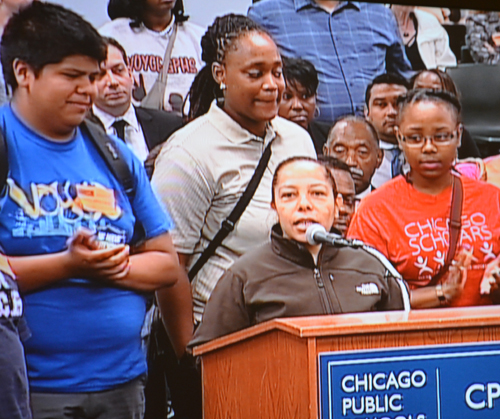 Myra Sarabia of the Southwest Organizing Project told the Board that nobody in the community wants the new Concept; charter school that the Board is forcing into the area. Sarabia and others noted that the city's real public schools had never been investigated by the FBI -- as Concept charter schools are. The FBI has raided Concept schools and offices in three states, including Illinois. Substance photo by George N. Schmidt.The next speaker was Myra Sarabia, representing the Southwest Organizing Project. She told the Board that her community did not want the new Concept charter school the Board was forcing into the community and said that the community wanted real public schools, not charters, to relieve the overcrowding in that part of town. For several years, CPS officials placed UNO charter schools into the Southwest Side instead of building new real public schools to deal with the overcrowding the threatens so many of the schools in that part of town. After UNO was completely discredited amid several scandals, the Board chose a charter school operator -- Concept Charter Schools -- that may be even more corrupt than UNO. If no action is taken to stop the Board, two Concept charter schools on the South Side will be given final approval at the Board's August meeting.
Myra Sarabia of the Southwest Organizing Project told the Board that nobody in the community wants the new Concept; charter school that the Board is forcing into the area. Sarabia and others noted that the city's real public schools had never been investigated by the FBI -- as Concept charter schools are. The FBI has raided Concept schools and offices in three states, including Illinois. Substance photo by George N. Schmidt.The next speaker was Myra Sarabia, representing the Southwest Organizing Project. She told the Board that her community did not want the new Concept charter school the Board was forcing into the community and said that the community wanted real public schools, not charters, to relieve the overcrowding in that part of town. For several years, CPS officials placed UNO charter schools into the Southwest Side instead of building new real public schools to deal with the overcrowding the threatens so many of the schools in that part of town. After UNO was completely discredited amid several scandals, the Board chose a charter school operator -- Concept Charter Schools -- that may be even more corrupt than UNO. If no action is taken to stop the Board, two Concept charter schools on the South Side will be given final approval at the Board's August meeting.
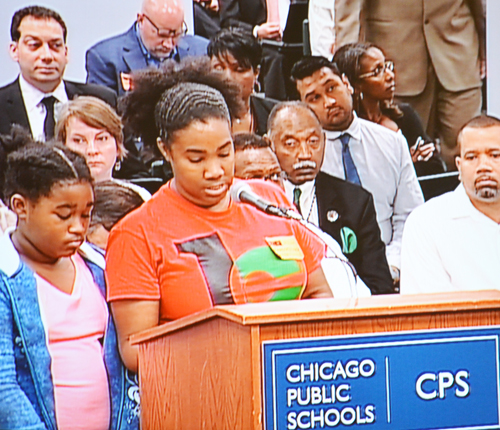 Teachers Kimberly Walls asked the Board members why they were forcing a Concept charter school on her South Side community, even thought Concept is under a federal FBI investigation. She also asked why the space for the school was in property owned by a powerful local minister who has close ties with Mayor Rahm Emanuel. When she waited for an answer from the silent Board members, Walls was pushed from the podium by CPS security guards. Substance photo by George N. Schmidt.The next speaker was Kimberly Walls, from South Shore Fine Arts High School who continued the challenge to the two new South Side "campuses" for Concept charter schools. Wearing her Chicago Teachers Union Black Caucus tee shirt, Walls asked the Board why they were pushing another charter school into her community, while the community wanted real public schools and Concept is under federal FBI investigation. She also asked the Board why the space for the Concept charter school was being rented, at public expense, from a minister with very close ties to Mayor Rahm Emanuel. After she asked her questions, Walls waits for answers from the silent Board members. Instead of answering her questions, the Board members nodded so that CPS security pulled the microphone away from the speaker and pushed her away from the podium.
Teachers Kimberly Walls asked the Board members why they were forcing a Concept charter school on her South Side community, even thought Concept is under a federal FBI investigation. She also asked why the space for the school was in property owned by a powerful local minister who has close ties with Mayor Rahm Emanuel. When she waited for an answer from the silent Board members, Walls was pushed from the podium by CPS security guards. Substance photo by George N. Schmidt.The next speaker was Kimberly Walls, from South Shore Fine Arts High School who continued the challenge to the two new South Side "campuses" for Concept charter schools. Wearing her Chicago Teachers Union Black Caucus tee shirt, Walls asked the Board why they were pushing another charter school into her community, while the community wanted real public schools and Concept is under federal FBI investigation. She also asked the Board why the space for the Concept charter school was being rented, at public expense, from a minister with very close ties to Mayor Rahm Emanuel. After she asked her questions, Walls waits for answers from the silent Board members. Instead of answering her questions, the Board members nodded so that CPS security pulled the microphone away from the speaker and pushed her away from the podium.
Rodney Estvan, who works at Access Living Chicago, next made brief remarks to the Board about the proposed budget, explaining that his group, along with the Civic Federation, opposed the budget because it is "unsustainable" and because CPS needs to find ways in increase revenues without constantly saying that Illinois must pay more. Access Living had issued a 22-page report on the budget earlier. Estvan, who has been analyzing CPS budgets for years and years, also thanked the Board and Ginger Ostro for making the information more accessible this year, as compared with previous years.
After ignoring the previous speakers' questions, Board member Jesse Ruiz asked Estvan to read the opening two sentences from his report. He did, as critics in the audience noted that Ruiz didn't have the courtesy to answer others' questions, but then found the energy to get a speaker to read -- beyond the two - minute limit -- words favorable to CPS. The stage was set for some dramatic confrontations to come, as restless members of the public, many of whom had seen their own children's schools closed a year earlier and all of whom had seen major cuts to their schools' budgets, began expressing anger at what they considered the hypocrisy of the Board members, especially Jesse Ruiz, who is the Board's Vice President.
Estvan decided to read what Ruiz requested, the first two sentences from the "Executive Summary" of a 22-page report, most of which was highly critical of the Board. "The FY 2015 budget totaling $5.5 billion proposed by CPS is one of the better written budget documents CPS had produced. There is more data, in particular about charter schools, in this document than has been available in the past." Ruiz didn't request that any of those who outlined the crimes and corruption of the charter schools he and his colleagues had been supporting go into detail about their complaints, nor has he acknowledged that his vote a year ago on the schools closings was based on the lie that claimed CPS would "save money" by undermining such a large number of public schools and Chicago communities.
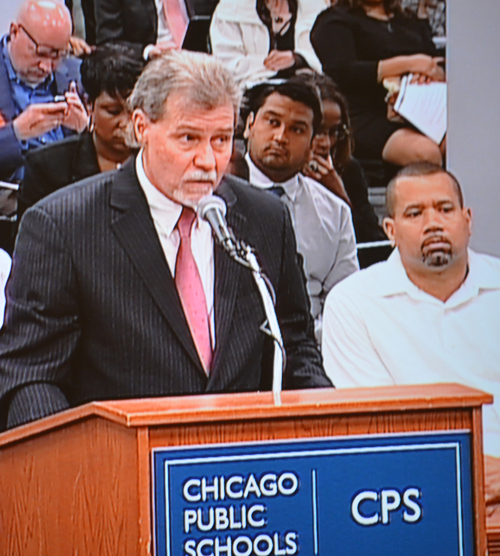 Rodney Estvan, who wrote the 22-page analysis of the CPS budget for Access Living Chicago, a major disability rights group, told the Board that Access Living (along with the Civic Federation, which did not show up at the Board meeting) could not support the proposed budget. He said that the Board needed to increase revenues to correct an untenable reality. Substance photo by George N. Schmidt. When Estvan then returned to his critical remarks (as is most of the 22-page report), noting that the Board had once again refused to hold a public meeting of its "Audit and Finance Committee" (which last met more than three years ago), the Board Secretary called "Time" and Estvan walked away from the podium.
Rodney Estvan, who wrote the 22-page analysis of the CPS budget for Access Living Chicago, a major disability rights group, told the Board that Access Living (along with the Civic Federation, which did not show up at the Board meeting) could not support the proposed budget. He said that the Board needed to increase revenues to correct an untenable reality. Substance photo by George N. Schmidt. When Estvan then returned to his critical remarks (as is most of the 22-page report), noting that the Board had once again refused to hold a public meeting of its "Audit and Finance Committee" (which last met more than three years ago), the Board Secretary called "Time" and Estvan walked away from the podium.
Shawn Gowder, from Barton Elementary School, almost laughed at the Board over the recent scandal in Connecticut. The latest scandal involves an AUSL official who, it turned out, had fraudulently claimed he had a "PhD from Stanford University."
During the week prior to the July 23 Chicago Board meeting, the news media in Connecticut was filled with investigative reports that Terrence Carter, who had once served as principal of Barton, was on the verge of being confirmed as superintendent of the New London public schools. Then several investigations showed he had made false claims on his resumes and other documents over the years.
One of those was a submission to CPS from AUSL that showed that "Dr. Carter" would be part of the AUSL "team" that helped coach the "turnaround" of Collins High School. Another was a biography for a conference where he claimed to be a Stanford University PhD. Carter was one day away from being hired by the New London school board when the weight of the scandals stopped the process. One of the reasons New London Board members said that Carter was "highly touted" was the claim that he had been a colleague of Arne Duncan in Chicago. The scandal was the second in six months in Connecticut involving a Chicago fraud. Earlier in the year, Bridgeport had dumped Paul Vallas when a lawsuit forced local officials to follow state law and require Vallas to have a real Connecticut license to run school.
Gowder noted that the Chicago Board of Education and Chicago's newspapers failed to notice the various misrepresentations of Carter's record during the brief time the Board placed him at Barton as principal. Barton was forced to have Carter as his principal a few years ago. Gowder also told the Board that the city had to stop taking the TIF money away from the schools.
Proving that Gresham Elementary School was not going to die even thought the Board was paying nearly a half million dollars to AUSL for the first year of the school's "turnaround," Gregory Clement and Venrita Farmer spoke after Gowder. Neither knew about the fraudulent AUSL official who was being exposed in Connecticut.
Gregory Clement told the Board that the turnaround at Gresham, following the years of sabotage of the school that has been well documented both during the hearings on the turnaround and in front of the Board, was what led to the Board's pretext for destroying the school. He also reminded the Board members about integrity, reciting the Boy Scout Oath at the meeting. Clement had been head of a Boy Scout troop at Gresham, as well as one of the public spokesmen against the so-called "turnaround."
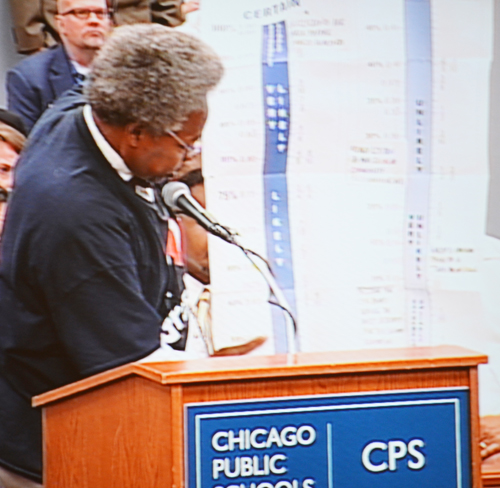 Gregory Clement continued his advocacy for Gresham Elementary School by suggesting that the members of the Board of Education follow the Boy Scout pledge (Clement sponsored the Boy Scout troop at Gresham). He unfurled a chart showing that the vast majority of the people in the Gresham community were opposed to the AUSL "turnaround" now being forced on the school. Substance photo by George N. Schmidt.Clement completed his remarks by unfurling a large chart which showed the results of a canvass of the Gresham community showing that the vast majority of citizens in the area opposed the Board's version of reality (that Gresham was "failing") and the expensive AUSL "turnaround" that had ripped the school's veteran teachers away from the community.
Gregory Clement continued his advocacy for Gresham Elementary School by suggesting that the members of the Board of Education follow the Boy Scout pledge (Clement sponsored the Boy Scout troop at Gresham). He unfurled a chart showing that the vast majority of the people in the Gresham community were opposed to the AUSL "turnaround" now being forced on the school. Substance photo by George N. Schmidt.Clement completed his remarks by unfurling a large chart which showed the results of a canvass of the Gresham community showing that the vast majority of citizens in the area opposed the Board's version of reality (that Gresham was "failing") and the expensive AUSL "turnaround" that had ripped the school's veteran teachers away from the community.
Vernita Farmer also spoke in defense of Greshman, where the veteran staff has now been replaced by the AUSL-trained "turnaround" people as the school moves towards it September 2014 opening as a "turnaround school."
Nelson Soza of the Pilsen Alliance spoke angrily about the policies of the Board and the priorities of the budget, with the result that Vitale ordered security to pull him away from the microphone.
Shelly Nation-Watson told the Board that she was the counselor at Montefiore and that she has been hearing regularly from families who want to have their young male children placed into Montefiore. The Board of Education has been blocking those placements since the Board closed Las Casas Occupational High School and Northside Learning Center and told the world that the special needs kids once served by those schools would be sent to Montefiore.
When the Secretary called out the name of "Queen Sister" to speak, no one approached the podium. But many possible speakers had been kept out of the Board chambers (and as it turned out, Queen Sister got back to the chambers prepared to speak a little later). One of the results of the Board's misuse of the seats in the public part of the chambers is that many parents, community leaders, students and teachers are unable to get into the meeting and are shunted to the "holding room" ten floors above.
At about this time, a shout rang out, "Jesse Ruiz, you're a coward..."
The Board Vice President, Jesse Ruiz, was walking out of the Board Chambers through the Board members's exit (carefully guarded by two security guards and not accessible to any member of the press or public) and a parent angrily denounced him. Ruiz, who had for a time tried to utilize his "street cred" as coming from humble roots in Humboldt Park, has been the subject of particular anger from that community after he went along with the Board's massive school closings of 50 schools in May 2013. He once would repeat the story about how his father had only finished seventh grade but how he, Jesse, had made good (and is now a millionaire lawyer), but does not do that any longer because of the angry response from members of the community.
A major squabble began on one side of the Chambers, bringing the public participation to a halt for a moment. Despite the attempts by CPS security to keep reporters and news photographers (and videographers) from going to where the squabble was taking place (the CPS chief of security had warned me that I would be "removed" from the meeting if I continued to "disrupt" it by moving around, and I had told her that I go where the story is, and not where an agent of the government tells me to sit down and shut up), just about everyone got to the scene of the action as CPS security were dragging away a young man and a young woman. (The whole story has been reported elsewhere in this month's Substance; the URL is ________________).
Dianne Daleiden was called, and criticized the Board of Education for disrupting the schools and community in Andersonville by allowing the expansion of the Passages Charter School, which is run by the clout-heavy American Quality Schools (headed by former Illinois Schools Chief Michael Bakalis). Her remarks are published separately in this Substance, the URL is ____________).
Claudia Cueva of Roosevelt High School spoke against the latest round of cuts at Roosevelt in Spanigh, with a translator.
She was followed by Tim Meegan, a Roosevelt teacher and union leader, who elaborated on how much the Board had undermined Roosevelt. Meegan's remarks were provided by him to Substance:
"When I stood before the Board last year I described the budget, pension, and underutilization crises as manufactured in order to force privatization. The Broad school closure guide, and Center for Reinventing Public Education�s (CRPE) student-based budgeting and portfolio district models are tools used to turn our schools over to private corporations.
"Despite two charter operators currently under investigation, charters saw an increase of $62 million and neighborhood schools were cut $67 million. This reflects the Board�s budgeting priorities.
"Roosevelt High School has seen a two-year loss of over $1.8 million and 20 positions despite only 99 fewer students over the same period. Stop playing games with funding for our schools. Every year since 2001 you plug the hole with one time reserves. How can there be $740 million in central office cuts when the entire central office budget was only $200 million in 2006?
"We now have a three-tiered education system of magnets, charters, and neighborhood schools. Magnets get up to 8 positions paid by the Board. The kids that need the least support get the most. Charters get special allowances and private funding.
"How can you spend $60 million on another North side magnet named after the first black president when the media reports skyrocketing white enrollment and plummeting black enrollment at magnet schools! You are resegregating the public schools!"
Board security officers tried to interrupt the end of Meegan's speech, but he completed it despite the disruption at the podium ordered by David Vitale.
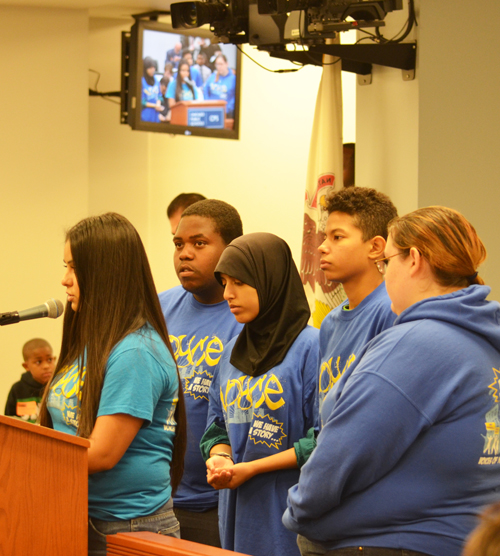 Steinmetz High School student Dalia Mena was one of several student speakers who opposed the budget priorities of the Board and pointed out how the cuts of the past two years had hurt her school. Substance photo by George N. Schmidt. Almost immediately after Meegan and Cueva outlined the impact of the cuts on Roosevelt High School, Dalia Mena, who signed up as being from "Chicago Students Organizing to Save Our Schools," outlined the impact of the cuts on Steinmetz High School also on the Northwest Side. Like others before her, Mena outlined the impact of the cuts on her high school, Steinmetz on the Northwest Side, and asked that the Board stop cutting out the chances for her and her fellow students.
Steinmetz High School student Dalia Mena was one of several student speakers who opposed the budget priorities of the Board and pointed out how the cuts of the past two years had hurt her school. Substance photo by George N. Schmidt. Almost immediately after Meegan and Cueva outlined the impact of the cuts on Roosevelt High School, Dalia Mena, who signed up as being from "Chicago Students Organizing to Save Our Schools," outlined the impact of the cuts on Steinmetz High School also on the Northwest Side. Like others before her, Mena outlined the impact of the cuts on her high school, Steinmetz on the Northwest Side, and asked that the Board stop cutting out the chances for her and her fellow students.
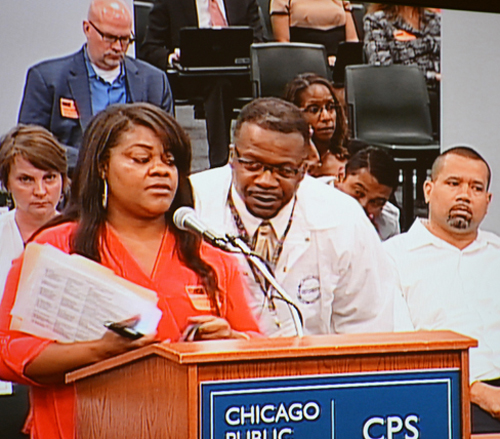 CPS clerk and militant Mom Shoenice Reynolds outlined the Board of Education's sabotage of the black community through the closing of real public schools and the opening of charter schools across the South Side and West Side. The process of sabotage, which began under Paul Vallas (1995 - 2001), escalated under Arne Duncan (2001 - 2009) and has reached a peak under the various Rahm Emanuel CEOs (since 2011) involved a couple of steps, each masked by the mantra of "choice." First, CPS places a charter school in a community, claiming there is a "need" (either "choice," or "overcrowding" in most cases). CPS and corporate forces then subsidize the charter school's marketing in two ways -- extra dollars and CPS giving the charter contact information for the "best" students in nearby schools. Finally, when the "best" (i.e. highest scoring and best behaved) students are gone from the local school, CPS proclaims that the local school is a "failure." At that point, as happened most recently with Dvorak, McNair and Gresham, the Board orders the school "reconstituted." The patronage part of "reconstitution" comes when CPS hires AUSL as a "consultant" to perform a "turnaround". "Turnaround' is an additional fiction that involves firing all the staff, from the principal through the lunchroom staff and replacing them with AUSL-trained staff who believe that "all children can learn" (as if the regular staff never believed that) and who have been trained in a secret methodology (which mostly involves getting rid of "bad" kids during the first year so the scores go "up) for a couple of years). Numerous parents and community leaders have figured out the mendacious formula and are denouncing it. Substance photo by George N. Schmidt. Shoenice Reynolds, a parent, community activist, and school clerk, denounced the Board for sabotaging the Black community's schools by undermining the schools through the placement of charters and libeling the schools' staffs through the documentations used for "reconstitution," "turnaround," and outright closings.
CPS clerk and militant Mom Shoenice Reynolds outlined the Board of Education's sabotage of the black community through the closing of real public schools and the opening of charter schools across the South Side and West Side. The process of sabotage, which began under Paul Vallas (1995 - 2001), escalated under Arne Duncan (2001 - 2009) and has reached a peak under the various Rahm Emanuel CEOs (since 2011) involved a couple of steps, each masked by the mantra of "choice." First, CPS places a charter school in a community, claiming there is a "need" (either "choice," or "overcrowding" in most cases). CPS and corporate forces then subsidize the charter school's marketing in two ways -- extra dollars and CPS giving the charter contact information for the "best" students in nearby schools. Finally, when the "best" (i.e. highest scoring and best behaved) students are gone from the local school, CPS proclaims that the local school is a "failure." At that point, as happened most recently with Dvorak, McNair and Gresham, the Board orders the school "reconstituted." The patronage part of "reconstitution" comes when CPS hires AUSL as a "consultant" to perform a "turnaround". "Turnaround' is an additional fiction that involves firing all the staff, from the principal through the lunchroom staff and replacing them with AUSL-trained staff who believe that "all children can learn" (as if the regular staff never believed that) and who have been trained in a secret methodology (which mostly involves getting rid of "bad" kids during the first year so the scores go "up) for a couple of years). Numerous parents and community leaders have figured out the mendacious formula and are denouncing it. Substance photo by George N. Schmidt. Shoenice Reynolds, a parent, community activist, and school clerk, denounced the Board for sabotaging the Black community's schools by undermining the schools through the placement of charters and libeling the schools' staffs through the documentations used for "reconstitution," "turnaround," and outright closings.
BOARD OF EDUCATION PRESS RELEASE ANNOUNCING THE BOARD VOTE TO APPROVE THE PROPOSED BUDGET:
Board of Education Approves FY15 Budget to Raise Per Pupil Spending and Maximize Classroom Investments Across the City $5.7 Billion Budget Provides Critical Resources to Schools Despite Significant Budget Deficit
CHICAGO � The Chicago Board of Education voted without opposition today to pass Chicago Public Schools� (CPS) proposed budget for Fiscal Year 2015 (FY15), which will protect crucial investments throughout the district and provide every student in Chicago with the high-quality educational resources they deserve. Despite a nearly $1 billion budget deficit, which is largely driven by skyrocketing pension costs and insufficient state funding, CPS students and families will benefit from an FY15 budget that makes significant investments in district priorities.
�The budget passed today provides our students with tools, resources and facilities that will promote success in the classroom and beyond,� said CPS CEO Barbara Byrd-Bennett. �While we have allocated funding to support key priority areas and crucial needs, this budget reflects the reality of our serious fiscal challenges. We will always strive to direct as much funding as possible to classrooms, but without action from Springfield to bolster state funding and act on comprehensive pension reform, the district will have to make even more difficult decisions in the future.�
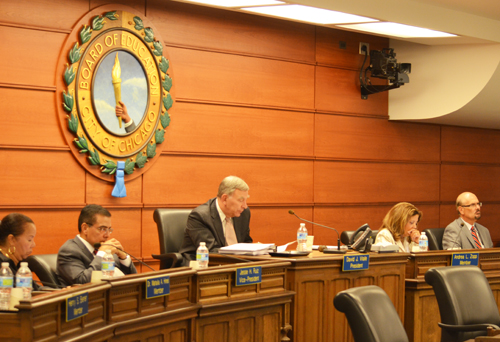 Five of the six members of the Board of Education who were present on July 23 were reading documents about the Hanson Park overcrowding while the Hanson Park people were speaking. Above, left to right Mahalia Hines, Jesse Ruiz, David Vitale, Andrea Zopp, and Carlos Azcoitia. Henry Bienen, who was present on July 23, was to the left and couldn't be included in the photograph because of the angles CPS creates for photographing the Board meetings. Deborah Quazzo was absent. Substance photo by George N. Schmidt.In order to provide principals with increased flexibility to allocate core instruction dollars, CPS�s FY15 budget boosts per pupil funding by $250. The District�s increase in per pupil funding was only possible following a dedicated effort to streamline Central Office operations to reduce spending and prevent cuts to school funding. This year, CPS has reduced Central Office, administrative and operational funding by $55 million, which is part of $740 million in cuts away from the classroom since 2011.
Five of the six members of the Board of Education who were present on July 23 were reading documents about the Hanson Park overcrowding while the Hanson Park people were speaking. Above, left to right Mahalia Hines, Jesse Ruiz, David Vitale, Andrea Zopp, and Carlos Azcoitia. Henry Bienen, who was present on July 23, was to the left and couldn't be included in the photograph because of the angles CPS creates for photographing the Board meetings. Deborah Quazzo was absent. Substance photo by George N. Schmidt.In order to provide principals with increased flexibility to allocate core instruction dollars, CPS�s FY15 budget boosts per pupil funding by $250. The District�s increase in per pupil funding was only possible following a dedicated effort to streamline Central Office operations to reduce spending and prevent cuts to school funding. This year, CPS has reduced Central Office, administrative and operational funding by $55 million, which is part of $740 million in cuts away from the classroom since 2011.
As a result of the District�s streamlining of Central Office, 97 percent of positions and 85 percent of all CPS expenditures in FY15 are directed to schools.
Despite significant financial constraints, the FY15 budget makes necessary, lasting investments in the district�s key priority areas to drive student achievement. In FY15, CPS is adding five new IB feeder schools, providing $2 million to expand IB programs and $8 million in capital build-out. This is in addition to the 6,000 students who have gained access to 12 high school and six elementary IB programs that have been established since 2011.
As part of the District�s effort to ensure that 100 percent of CPS students are college ready and college bound, the FY15 budget includes support to add 15 additional high schools to the dual credit dual enrollment program, which allows students to receive credit toward a college degree. The increased capacity provided in the FY15 budget will increase dual credit enrollment from approximately 300 students in FY11 to 4,700 students in FY15.
In order to support CPS�s new arts plan and physical education (PE) requirements, the FY15 budget contains $13 million in funding for 84 arts and 84 PE teachers at 171 schools. With the implementation of CPS�s new arts plan, CPS will be the first large school district in the country to offer an arts liaison for every high school.
The FY15 budget includes $510 million in capital spending, which will provide students and staff throughout the district with the high-quality facilities and resources they deserve. In order to reduce significant overcrowding at District schools, the FY15 budget funds the construction of annexes at Arthur E. Canty Elementary School (50 percent over-capacity), Minnie Mars Jamieson Elementary School (30 percent over-capacity) and Richard Edwards Elementary School (69 percent over-capacity). These schools are among the city�s most over-utilized schools, and the annexes will allow each school to appropriately handle the expected growth of each school community.
Following School Year 2013-2014, which was the safest school year on record since CPS started tracking student safety data, the FY15 budget includes a $1 million expansion of the successful Safe Passage program. The additional funds provided in the FY15 budget will allow the District to expand Safe Passage to six additional schools. This past school year, the Safe Passage program served 94 schools and protected 53,227 students in Chicago.
While the District�s FY15 budget makes many significant investments that will help provide Chicago�s children with a path to success, it was only able to do so after closing a nearly $1 billion budget deficit. The district was able to close the budget gap by extending its revenue recognition period to August 29, which is 60 days after the end of the fiscal year � a practice that brings CPS in line with the City of Chicago and the majority of school districts in Cook County. This is a one-time fix that allows the District to prevent further cuts to school budgets in the absence of increased state funding or comprehensive pension reform from Springfield. Illinois is currently last in the nation in education funding and without increased funding or pension reform, the District may not be able to prevent cuts to the classroom in future budgets.
For additional information on the FY15 budget, please visit www.cps.edu/budget.

